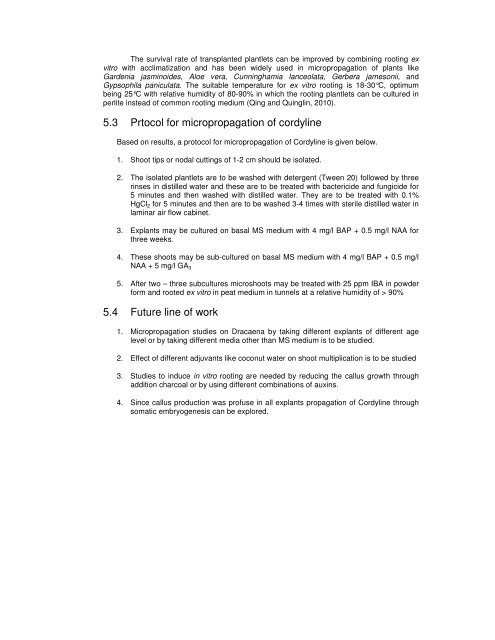micropropagation studies in dracaena and cordyline - ETD ...
micropropagation studies in dracaena and cordyline - ETD ...
micropropagation studies in dracaena and cordyline - ETD ...
Create successful ePaper yourself
Turn your PDF publications into a flip-book with our unique Google optimized e-Paper software.
The survival rate of transplanted plantlets can be improved by comb<strong>in</strong><strong>in</strong>g root<strong>in</strong>g ex<br />
vitro with acclimatization <strong>and</strong> has been widely used <strong>in</strong> <strong>micropropagation</strong> of plants like<br />
Gardenia jasm<strong>in</strong>oides, Aloe vera, Cunn<strong>in</strong>ghamia lanceolata, Gerbera jamesonii, <strong>and</strong><br />
Gypsophila paniculata. The suitable temperature for ex vitro root<strong>in</strong>g is 18-30°C, optimum<br />
be<strong>in</strong>g 25°C with relative humidity of 80-90% <strong>in</strong> which the root<strong>in</strong>g plantlets can be cultured <strong>in</strong><br />
perlite <strong>in</strong>stead of common root<strong>in</strong>g medium (Q<strong>in</strong>g <strong>and</strong> Qu<strong>in</strong>gl<strong>in</strong>, 2010).<br />
5.3 Prtocol for <strong>micropropagation</strong> of cordyl<strong>in</strong>e<br />
Based on results, a protocol for <strong>micropropagation</strong> of Cordyl<strong>in</strong>e is given below.<br />
1. Shoot tips or nodal cutt<strong>in</strong>gs of 1-2 cm should be isolated.<br />
2. The isolated plantlets are to be washed with detergent (Tween 20) followed by three<br />
r<strong>in</strong>ses <strong>in</strong> distilled water <strong>and</strong> these are to be treated with bactericide <strong>and</strong> fungicide for<br />
5 m<strong>in</strong>utes <strong>and</strong> then washed with distilled water. They are to be treated with 0.1%<br />
HgCl2 for 5 m<strong>in</strong>utes <strong>and</strong> then are to be washed 3-4 times with sterile distilled water <strong>in</strong><br />
lam<strong>in</strong>ar air flow cab<strong>in</strong>et.<br />
3. Explants may be cultured on basal MS medium with 4 mg/l BAP + 0.5 mg/l NAA for<br />
three weeks.<br />
4. These shoots may be sub-cultured on basal MS medium with 4 mg/l BAP + 0.5 mg/l<br />
NAA + 5 mg/l GA 3<br />
5. After two – three subcultures microshoots may be treated with 25 ppm IBA <strong>in</strong> powder<br />
form <strong>and</strong> rooted ex vitro <strong>in</strong> peat medium <strong>in</strong> tunnels at a relative humidity of > 90%<br />
5.4 Future l<strong>in</strong>e of work<br />
1. Micropropagation <strong>studies</strong> on Dracaena by tak<strong>in</strong>g different explants of different age<br />
level or by tak<strong>in</strong>g different media other than MS medium is to be studied.<br />
2. Effect of different adjuvants like coconut water on shoot multiplication is to be studied<br />
3. Studies to <strong>in</strong>duce <strong>in</strong> vitro root<strong>in</strong>g are needed by reduc<strong>in</strong>g the callus growth through<br />
addition charcoal or by us<strong>in</strong>g different comb<strong>in</strong>ations of aux<strong>in</strong>s.<br />
4. S<strong>in</strong>ce callus production was profuse <strong>in</strong> all explants propagation of Cordyl<strong>in</strong>e through<br />
somatic embryogenesis can be explored.

















